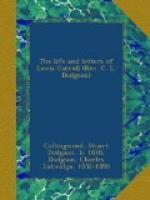In accordance with his expressed wish, the funeral was simple in the extreme—flowers, and flowers only, adorned the plain coffin. There was no hearse to drag it up the steep incline that leads to the beautiful cemetery where he lies. The service was taken by Dean Paget and Canon Grant, Rector of Holy Trinity and S. Mary’s, Guildford. The mourners who followed him in the quiet procession were few—but the mourners who were not there, and many of whom had never seen him—who shall tell their number?
After the grave had been filled up, the wreaths which had covered the coffin were placed upon it. Many were from “child-friends” and bore such inscriptions as “From two of his child-friends”—“To the sweetest soul that ever looked with human eyes,” &c. Then the mourners left him alone there—up on the pleasant downs where he had so often walked.
A marble cross, under the shadow of a pine, marks the spot, and beneath his own name they have engraved the name of “Lewis Carroll,” that the children who pass by may remember their friend, who is now—himself a child in all that makes childhood most attractive—in that “Wonderland” which outstrips all our dreams and hopes.
I cannot forbear quoting from Professor Sanday’s sermon at Christ Church on the Sunday after his death:—
The world will think of Lewis Carroll as one who opened out a new vein in literature, a new and a delightful vein, which added at once mirth and refinement to life.... May we not say that from our courts at Christ Church there has flowed into the literature of our time a rill, bright and sparkling, health-giving and purifying, wherever its waters extend?
[Illustration: Lewis Carroll’s grave. From a photograph.]
On the following Sunday Dean Paget, in the course of a sermon on the “Virtue of Simplicity,” said:—




